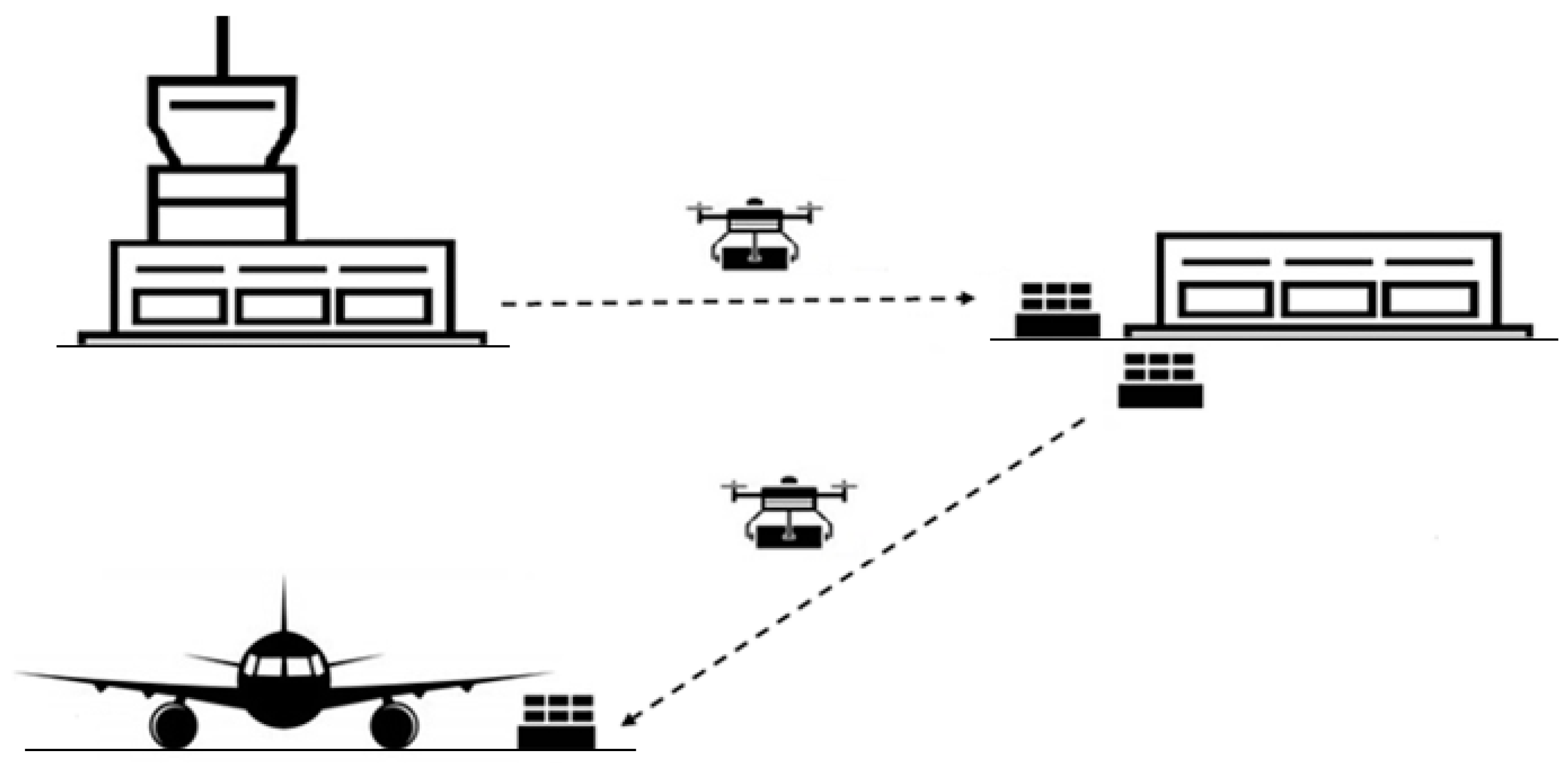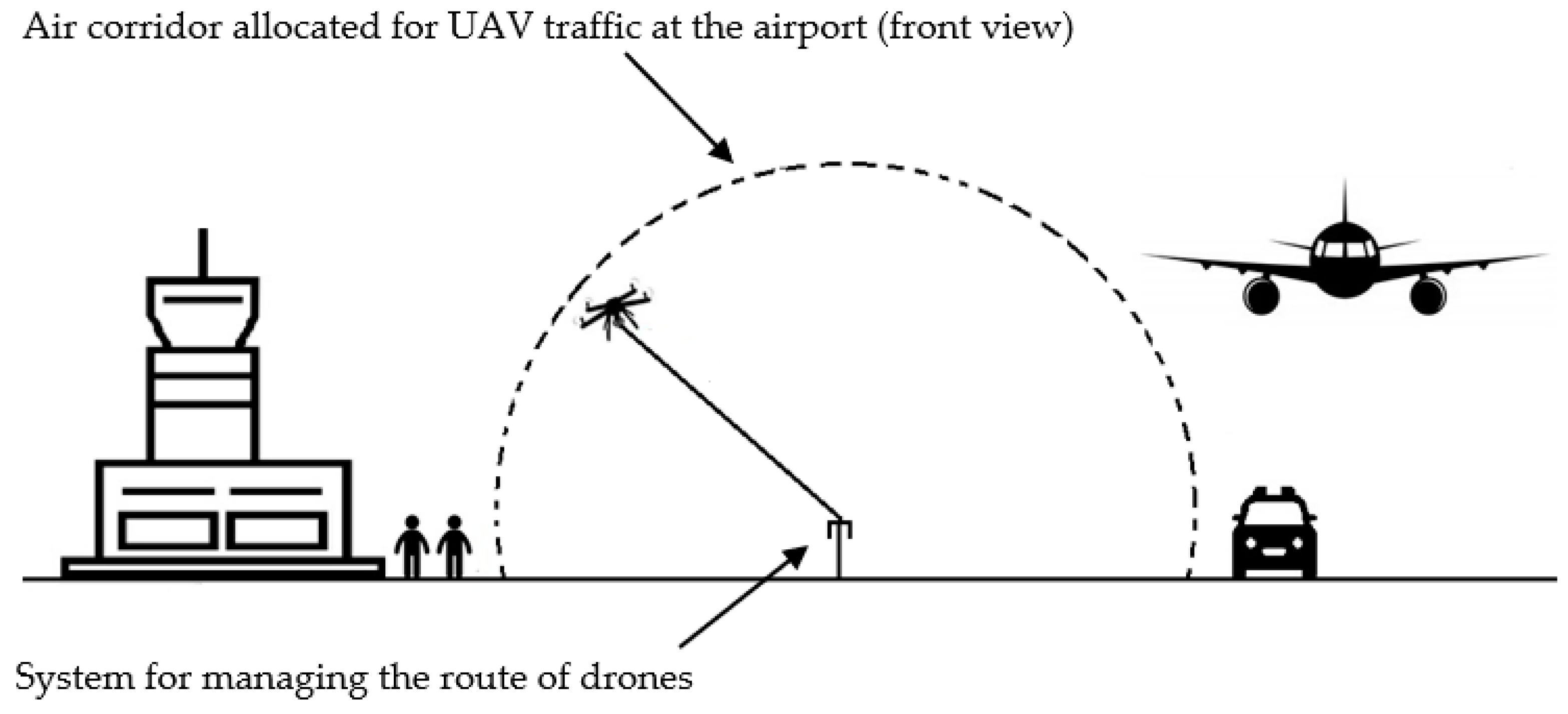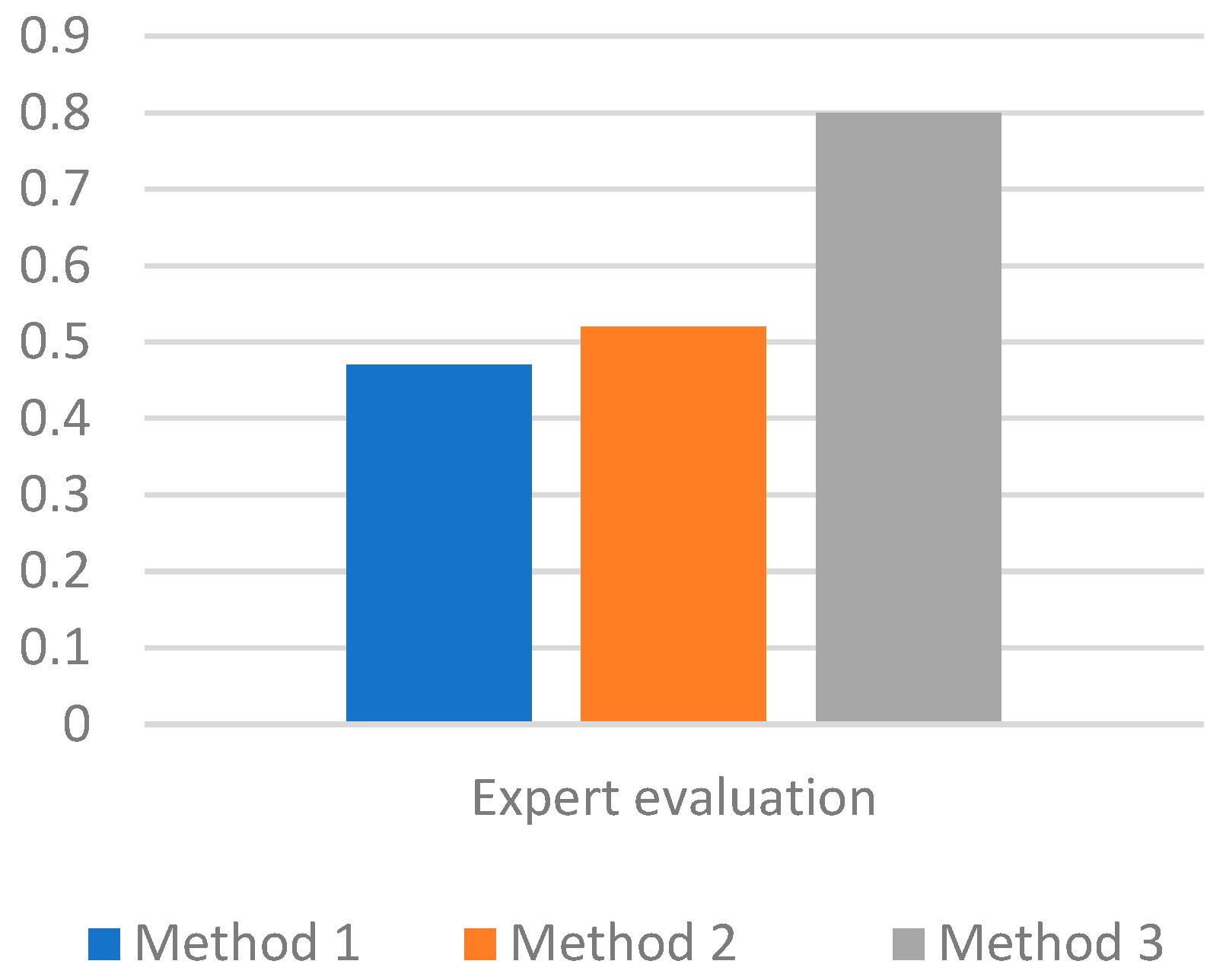Evaluation of the Prospects for the Admission of Electric Multicopters to Operation at Airports, Subject to the Joint Use of Modern Methods of Ensuring Safety of the Movement
Abstract
:1. Introduction
1.1. Perspective Directions of Application of UAVs at Airports
1.2. Type of UAV Suitable for Airport Operation
1.3. Current Restrictions on the Use of Electric Multicopters at Airports
2. Analysis of Methods for Ensuring the Safety of Movement of Electric Multicopters during Their Operation at the Airport
- -
- -
3. Assessment of the Prospects for the Admission of Electric Multicopters for Operation at the Airport
- (M1) Allocation for the operation of EMs of individual sectors or air corridors at the airport;
- (M2) Application of the drone route control system during the operation of the EV at the airport;
- (M3) Joint application of methods M1 and M2.
- The sum of the ranks obtained by each estimated algorithm was calculated.
- The arithmetic mean sum of the ranks was calculated.
- The deviation of the sum of ranks of each factor (M1–M3) from the arithmetic mean sum of ranks was calculated.
- The deviation of the sums of the ranks of each factor was squared and the obtained numbers were summed up; as a result, the sum of squares of the rank differences (S) was found.
4. Results
5. Discussion
Funding
Institutional Review Board Statement
Informed Consent Statement
Data Availability Statement
Conflicts of Interest
References
- ICAO Safety Report 2020. Available online: https://www.icao.int/safety/Documents/ICAO_SR_2020_final_web.pdf (accessed on 10 February 2022).
- IATA. Runway Safety Accident Analysis Report; Technical Report. International Air Transport Association, 2020. Available online: https://www.iata.org/en/publications/safety-report/ (accessed on 10 February 2022).
- Alomar, I.; Tolujevs, J. Optimization of ground vehicles movement on the aerodrome. Transp. Res. Procedia 2017, 24, 58–64. [Google Scholar] [CrossRef]
- Wilke, S.; Majumdar, A.; Ochieng, W.Y. Airport surface operations: A holistic framework for operations modeling and risk management. Saf. Sci. 2014, 63, 18–33. [Google Scholar] [CrossRef]
- Sultonov, F.; Park, J.-H.; Yun, S.; Lim, D.-W.; Kang, J.-M. Mixer U-Net: An Improved Automatic Road Extraction from UAV Imagery. Appl. Sci. 2022, 12, 1953. [Google Scholar] [CrossRef]
- Flammini, F.; Pragliola, C.; Smarra, G. Railway infrastructure monitoring by drones. In Proceedings of the 2016 International Conference on Electrical Systems for Aircraft, Railway, Ship Propulsion and Road Vehicles & International Transportation Electrification Conference (ESARS-ITEC), Toulouse, France, 2–4 November 2016; pp. 1–6. [Google Scholar] [CrossRef]
- Mann, S.; Pierce, C.; Hernandez, J.; Li, Q.; Zheng, B.C.; Xiang, Y.X. Drone Swarms for Sensing-of-Sensing. In Proceedings of the 2019 IEEE SENSORS, Montreal, QC, Canada, 27–30 October 2019; pp. 1–4. [Google Scholar] [CrossRef]
- Lyovin, B.A.; Shvetsov, A.V.; Setola, R.; Shvetsova, S.V.; Tesei, M. Method for remote rapid response to transportation security threats on high speed rail systems. Int. J. Crit. Infrastruct. 2019, 15, 324. [Google Scholar] [CrossRef]
- Sharma, M.; Gupta, A.; Gupta, S.K.; Alsamhi, S.H.; Shvetsov, A.V. Survey on Unmanned Aerial Vehicle for Mars Exploration: Deployment Use Case. Drones 2022, 6, 4. [Google Scholar] [CrossRef]
- Alsamhi, S.H.; Almalki, F.A.; AL-Dois, H.; Shvetsov, A.V.; Ansari, M.S.; Hawbani, A.; Gupta, S.K.; Lee, B. Multi-Drone Edge Intelligence and SAR Smart Wearable Devices for Emergency Communication. Wirel. Commun. Mob. Comput. 2021, 2021, 6710074. [Google Scholar] [CrossRef]
- Gopi, S.P.; Magarini, M.; Alsamhi, S.H.; Shvetsov, A.V. Machine Learning-Assisted Adaptive Modulation for Optimized Drone-User Communication in B5G. Drones 2021, 5, 128. [Google Scholar] [CrossRef]
- Alsamhi, S.H.; Almalki, F.A.; Afghah, F.; Hawbani, A.; Shvetsov, A.V.; Lee, B.; Song, H. Drones’ Edge Intelligence Over Smart Environments in B5G: Blockchain and Federated Learning Synergy. IEEE Trans. Green Commun. Netw. 2022, 6, 295–312. [Google Scholar] [CrossRef]
- Sun, Y.; Ma, O. Automating Aircraft Scanning for Inspection with a UAV and Reinforcement Learning Technique, Preprint (Version 1). 2021. Available online: https://doi.org/10.21203/rs.3.rs-1193469/v1 (accessed on 10 February 2022).
- Tzitzilonis, V.; Malandrakis, K.; Fragonara, L.Z.; Domingo, J.A.G.; Avdelidis, N.P.; Tsourdos, A.; Forster, K. Inspection of Aircraft Wing Panels Using Unmanned Aerial Vehicles. Sensors 2019, 19, 1824. [Google Scholar] [CrossRef] [Green Version]
- Siegel, M.; Gunatilake, P.; Podnar, G. Robotic assistants for aircraft inspectors. IEEE Instrum. Meas. Mag. 2018, 1, 16–30. [Google Scholar] [CrossRef]
- Blasch, E.; Wang, Z.; Shen, D.; Ling, H.; Chen, G. Surveillance of ground vehicles for airport security. In Proceedings of the SPIE 9089, Geospatial InfoFusion and Video Analytics IV; and Motion Imagery for ISR and Situational Awareness II, 90890B, Baltimore, MD, USA, 19 June 2014. [Google Scholar] [CrossRef]
- Gupta, A.; Afrin, T.; Scully, E.; Yodo, N. Advances of UAVs toward Future Transportation: The State-of-the-Art, Challenges, and Opportunities. Future Transp. 2021, 1, 326–350. [Google Scholar] [CrossRef]
- Škrinjar, J.P.; Skorput, P.; Furdić, M. Application of Unmanned Aerial Vehicles in Logistic Processes. In New Technologies, Development and Applications; Springer: Cham, Switzerland, 2018; pp. 359–366. [Google Scholar]
- Roca-Riu, M.; Menendez, M. Logistic deliveries with drones: State of the art of practice and research. In Proceedings of the 19th Swiss Transport Research Conference (STRC 2019), Ascona, Italy, 15–17 May 2019. [Google Scholar]
- Ozdemir, U.; Aktas, Y.O.; Vuruskan, A.; Dereli, Y.; Tarhan, A.F.; Demirbag, K.; Erdem, A.; Kalaycioglu, G.D.; Ozkol, I.; Inalhan, G. Design of a Commercial Hybrid VTOL UAV System. J. Intell. Robot. Syst. 2013, 74, 371–393. [Google Scholar] [CrossRef]
- Cherif, N.; Jaafar, W.; Yanikomeroglu, H.; Yongacoglu, A. Disconnectivity-Aware Energy-Efficient Cargo-UAV Trajectory Planning with Minimum Handoffs. In Proceedings of the ICC 2021-IEEE International Conference on Communications, Montreal, QC, Canada, 14–23 June 2021; pp. 1–6. [Google Scholar] [CrossRef]
- Stewart, M.; Martin, S. Unmanned Aerial Vehicles: Fundamentals, Components, Mechanics, and Regulations. In Unmanned Aerial Vehicles, Chapter 1; Nova Science Publishers: Hauppauge, NY, USA, 2020. [Google Scholar]
- VoloDrone. Available online: https://www.volocopter.com/solutions/volodrone/ (accessed on 10 February 2022).
- Boeing CAV. Available online: https://www.boeing.com/features/highlights/2020/cargo-air-vehicle/index.page (accessed on 10 February 2022).
- Shvetsov, A.V. Analysis of Emergency Situations Arising from the Interaction of Air and Ground Vehicles. Rus. Aer. 2021, 64, 805–809. [Google Scholar] [CrossRef]
- United States Government Accountability Office. Small Unmanned Aircraft Systems. FAA Should Improve Its Management of Safety Risks. GAO-18-110 Small Unmanned Aircraft Systems. Available online: https://www.gao.gov/assets/gao-18-110.pdf (accessed on 10 February 2022).
- UAS ATM Integration Operational Concept. 2018 European Organisation for the Safety of Air Navigation (Eurocontrol). Available online: https://www.eurocontrol.int/sites/default/files/publication/files/uas-atm-integration-operational-concept-v1.0-release%2020181128.pdf (accessed on 10 February 2022).
- Lykou, G.; Moustakas, D.; Gritzalis, D. Defending Airports from UAS: A Survey on Cyber-Attacks and Counter-Drone Sensing Technologies. Sensors 2020, 20, 3537. [Google Scholar] [CrossRef] [PubMed]
- Shvetsov, A.; Gromov, V. Analysis of The Airport Noise Impact on the Occurrence of Emergency Situations. Akustika 2021, 41, 22–24. [Google Scholar] [CrossRef]
- Shvetsov, A. Analysis of Accidents Resulting from the Interaction of Air and Ground Vehicles at Airports. Transp. Res. Procedia 2021, 59, 21–28. [Google Scholar] [CrossRef]
- Shvetsov, A. Methods of Reducing the Accident Rate of Technological Vehicles of the Airport. Transp. Res. Procedia 2022, 61, 537–541. [Google Scholar] [CrossRef]
- SESAR 2020. Eurocontrol. 2020. Available online: https://www.eurocontrol.int/publication/unmanned-aircraft-systems-uas-atm-integration (accessed on 10 February 2022).
- Unmanned Aircraft System Traffic Management; National Aeronautics and Space Administration (NASA): Washington, DC, USA, 2018. Available online: https://utm.arc.nasa.gov/index.shtml (accessed on 10 February 2022).
- UAS ATM Integration; European Organisation for the Safety of the Air Navigation: Brussels, Belgium, 2018; Available online: https://www.eurocontrol.int/sites/default/files/publication/files/uas-atm-integration-operational-concept-v1.0-release%2020181128.pdf (accessed on 10 February 2022).
- Shvetsova, S.; Shvetsov, A. 2020 Ensuring Safety and Security in Employing Drones at Airports. J. Transp. Secur. 2021, 14, 41–53. Available online: http://link.springer.com/article/10.1007/s12198-020-00225-z (accessed on 10 February 2022). [CrossRef]
- Thanh, H.L.N.N.; Hong, S.K. Completion of Collision Avoidance Control Algorithm for Multicopters Based on Geometrical Constraints. IEEE Access 2018, 6, 27111–27126. [Google Scholar] [CrossRef]
- Fourlas, G.K.; Karras, G.C. A Survey on Fault Diagnosis and Fault-Tolerant Control Methods for Unmanned Aerial Vehicles. Machines 2021, 9, 197. [Google Scholar] [CrossRef]
- Shvetsov, A.V.; Shvetsova, S.V. A Method for Managing the Route of an Unmanned Aerial Vehicle. Rus. Aer. 2021, 64, 142–145. [Google Scholar] [CrossRef]
- Huttunen, M. Civil unmanned aircraft systems and security: The European approach. J. Transp. Secur. 2019, 12, 83–101. [Google Scholar] [CrossRef] [Green Version]
- Pérez-Castán, J.A.; Comendador, F.G.; Cardenas-Soria, A.B.; Janisch, D.; Valdés, R.M.A. Identification, Categorisation and Gaps of Safety Indicators for U-Space. Energies 2020, 13, 608. [Google Scholar] [CrossRef] [Green Version]




| Evaluated Methods | Expert Room | ||||||
|---|---|---|---|---|---|---|---|
| 1 | 2 | 3 | 4 | 5 | 6 | 7 | |
| M1 | 0.5 | 0.6 | 0.4 | 0.6 | 0.4 | 0.5 | 0.6 |
| M2 | 0.6 | 0.5 | 0.5 | 0.5 | 0.6 | 0.5 | 0.5 |
| M3 | 0.7 | 0.9 | 0.8 | 0.9 | 0.7 | 0.8 | 0.8 |
| Evaluated Methods | Experts | Sum of Ranks | Deviation from the Average Amount of Ranks | Squares of Deviations of Rank Sums | ||||||
|---|---|---|---|---|---|---|---|---|---|---|
| 1 | 2 | 3 | 4 | 5 | 6 | 7 | ||||
| M1 | 1 | 2 | 1 | 2 | 1 | 1.5 | 2 | 10.5 | −3.5 | 12.25 |
| M2 | 2 | 1 | 2 | 1 | 2 | 1.5 | 1 | 10.5 | −3.5 | 12.25 |
| M3 | 3 | 3 | 3 | 3 | 3 | 3 | 3 | 21 | 7 | 49 |
| Sum | 73.5 | |||||||||
Publisher’s Note: MDPI stays neutral with regard to jurisdictional claims in published maps and institutional affiliations. |
© 2022 by the author. Licensee MDPI, Basel, Switzerland. This article is an open access article distributed under the terms and conditions of the Creative Commons Attribution (CC BY) license (https://creativecommons.org/licenses/by/4.0/).
Share and Cite
Shvetsov, A.V. Evaluation of the Prospects for the Admission of Electric Multicopters to Operation at Airports, Subject to the Joint Use of Modern Methods of Ensuring Safety of the Movement. World Electr. Veh. J. 2022, 13, 79. https://doi.org/10.3390/wevj13050079
Shvetsov AV. Evaluation of the Prospects for the Admission of Electric Multicopters to Operation at Airports, Subject to the Joint Use of Modern Methods of Ensuring Safety of the Movement. World Electric Vehicle Journal. 2022; 13(5):79. https://doi.org/10.3390/wevj13050079
Chicago/Turabian StyleShvetsov, Alexey V. 2022. "Evaluation of the Prospects for the Admission of Electric Multicopters to Operation at Airports, Subject to the Joint Use of Modern Methods of Ensuring Safety of the Movement" World Electric Vehicle Journal 13, no. 5: 79. https://doi.org/10.3390/wevj13050079
APA StyleShvetsov, A. V. (2022). Evaluation of the Prospects for the Admission of Electric Multicopters to Operation at Airports, Subject to the Joint Use of Modern Methods of Ensuring Safety of the Movement. World Electric Vehicle Journal, 13(5), 79. https://doi.org/10.3390/wevj13050079





